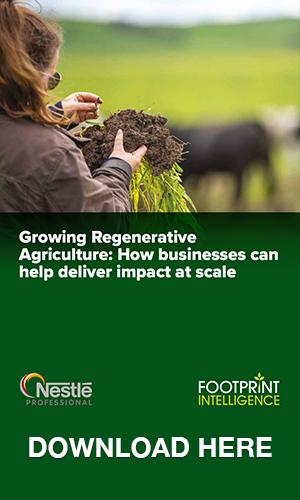Prized for their nutritional and environmental credentials, campaigners are queuing up to position pulses as a key future food. Nick Hughes reports.
The humble pulse is enjoying a revival. Having long played second fiddle to meat as a protein source, and rice and pasta as store cupboard staples, pulses – a food group that includes lentils, beans and peas – are making a comeback as unlikely heroes in the fight against climate change and malnutrition.
World pulses day on February 10th is now a designated United Nations event to recognise the importance of pulses as a global food. This year’s theme was to increase awareness of the role of pulses in ensuring sustainable future food systems.
Campaign groups have latched onto the role of pulses in helping people shift away from diets high in animal protein. Caterers are ramping up their use in menus as a low-carbon, low-cost alternative to meat. Suppliers such as Suffolk-based Hodmedod’s continue in their efforts to forge a domestic market for indigenous beans and pulses. Even the UK government is planning to pay farmers to grow pulses as part of a new sustainable farming scheme.
What’s driving this newfound enthusiasm for these unassuming edible seeds? The short answer is that as a nutritious, sustainable and affordable source of food pulses tick three key boxes for those looking to support the shift to a healthier, fairer, more resilient food system.
In November, a new campaign was launched with the aim of doubling global consumption of beans by 2028. Dubbed, ‘Beans is how’, the campaign is coordinated by the SDG2 (Sustainable Development Goal) Advocacy Hub, which coordinates global campaigning and advocacy to achieve the goal of ending hunger, achieving food security and improved nutrition, and promoting sustainable agriculture by 2030.
Launching the campaign, founding partners including The Kraft Heinz Company, Hodmedod’s, The Chefs’ Manifesto and the World Business Council for Sustainable Development cited evidence suggesting that global demand for protein will increase by almost 10% from 2020 to 2027 due to a rising population and dietary shifts. Beans, they noted, provide a major source of plant-based protein yet on average just 21g of pulses are eaten per person per day globally compared to 112g of meat, which has a significantly greater environmental footprint. “Everyone is worried at the moment – how can we make nutritious meals for our families when money is tight? How can we help tackle the climate crisis? How can we do something about the 3 billion people on this planet who are malnourished? Beans is how we do it,” says Paul Newnham, executive director of the SDG2 Advocacy Hub.
Pulse possibilities
In the UK, a new campaign from the charity Eating Better is hoping to raise awareness of the health, cost-saving and environmental benefits of pulses. The ‘Anything is pulse-able’ campaign highlights how lentils, peas and beans are the “unsung heroes” of the kitchen both as versatile store cupboard staples and for their nutrition, affordability and environmental credentials. “While there has been an increase in the people that have adopted a sustainable lifestyle in the last 12 months, including people reducing their meat consumption, research has shown that the barriers to more people being healthier and sustainable are related to cost and convenience,” says Simon Billing, executive director for Eating Better. “By providing information, inspiration and recipes, we want to show how even during a cost of living crisis, everyone can have access to affordable, healthy, and sustainable meals.”
Dried beans cost on average $1 (£0.84) per 500 grams, according to the ‘Beans is how’ campaign. They can also be stored for months on end without losing their high nutritional value.
As well as containing micronutrients, minerals and high quantities of fibre (three heaped tablespoons count as one of your 5-a-day), pulses also provide around 2-3 times the levels of protein found in cereal grains like wheat, rice, quinoa, oats, barley, and corn, according to the SDG2 Advocacy Hub. And while they can’t compete with animal protein as a protein source (pound-for-pound chicken contains four times more protein than pulses, according to the British Nutrition Foundation), their environmental credentials are hard to match. Pulses have a relatively low carbon footprint compared to other sources of protein: producing 1kg of beans emits around 2kg of CO2e, according to Eating Better. In comparison, 1kg of beef from a non-dairy herd produces 100kg of CO2e.
Growing pulses, including as a cover crop, can also benefit soil quality by fixing nitrogen and protecting soil microbes, reducing the need for synthetic fertilisers. Under the UK government’s new environmental land management schemes, farmers who incorporate pulses into their crop and grassland management to help build soil fertility will be rewarded under the sustainable farming incentive.
‘Favacado’
For caterers, the versatility of pulses is increasingly making them a go-to food group for chefs. “Pulses are a great part of any menu, “says Chantelle Nicholson, chef owner at Apricity. “Not only are they delicious, and satiating, but they are also beneficial from a financial perspective too, with a relatively low cost point. They’re also incredibly versatile, and particularly helpful when the vegetable variety is not as plentiful in the colder months.”
Pulses can be used as a base ingredient in a variety of recipes including daal and falafel, and can also replace meat either partly or entirely in dishes such as stews, chillis, bolognaises or burgers.
Mexican restaurant chain Wahaca uses British organic fava beans instead of avocados in its guacamole due to their environmental benefits. Compass UK & Ireland, meanwhile, said in its recently published climate impact report that emissions from meat had fallen 28% in FY2022 compared with the FY2019 baseline in part due to reformulating recipes to substitute meat with beans or pulses.
Flour power
There is growing interest in pulses in the world of academia too. Researchers and chefs at the University of Reading are working alongside members of the public, farmers, industry, and policy makers to encourage British consumers and food producers to switch to bread made using faba beans (also called fava beans but more commonly referred to as broad beans). The aim is to use faba bean flour, which is a good source of fibre and iron, to replace the imported soya flour and some of the wheat flour commonly used in making white bread.
The £2m, three-year, publicly-funded ‘Raising the pulse’ project, will see researchers work on optimising the sustainability and nutritional quality of faba beans grown in the UK with a view to encouraging farmers to switch some wheat producing land to faba beans for human consumption.
The project will also involve testing the appeal of novel foods made with faba beans with members of the public. Students at the University of Reading’s halls of residence will be asked to rate products made or enriched with faba beans, such as bread, flatbread and hummus.
Shifting schools
Another publicly-funded collaborative research project is exploring how to work with schools and caterers to encourage an increase in meals made with beans. The BeansMeals project follows on from the development of two varieties of haricot bean which are suitable for UK growing by a team at the University of Warwick – a blonde bean named godiva and a traditional white navy bean named capulet.
The project is being led by researchers at the Environmental Change Institute (ECI) at the University of Oxford in partnership with Leicestershire County Council and Leicester City Council and supported by Food for Life, a programme run by the Soil Association. As part of the project, the ECI team is working with children at schools across Leicestershire to find ways to encourage them to eat school meals made with the dried beans. The team will also be working with school food service provider, Leicestershire Traded Services, to adapt menus to include more beans.
While it’s fanciful to believe that pulses will replace meat as our main source of dietary protein any time soon, there’s enough substance behind the current push to suggest the revival of pulses will be permanent rather than a flash in the pan.









